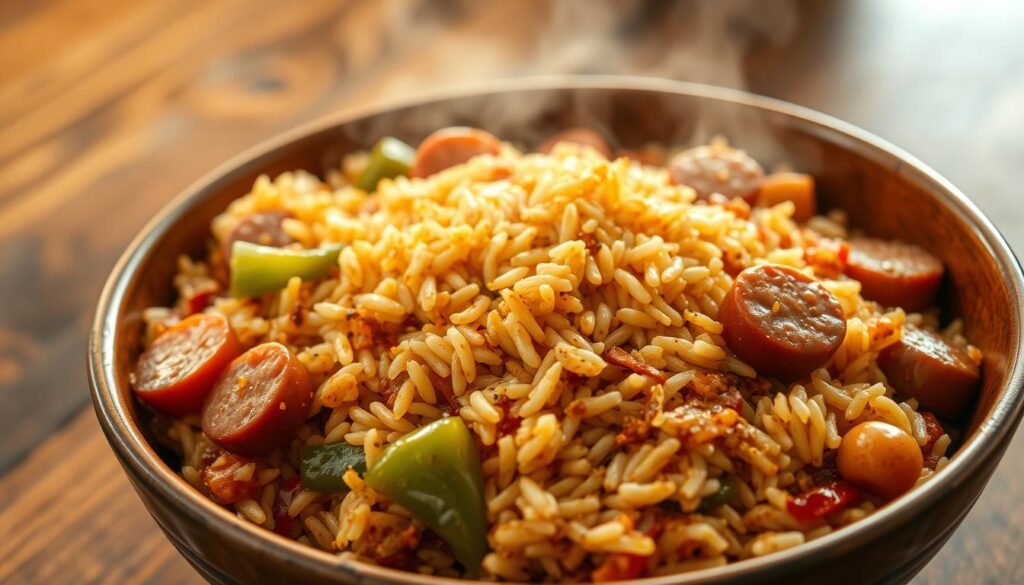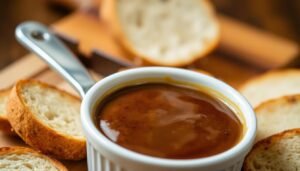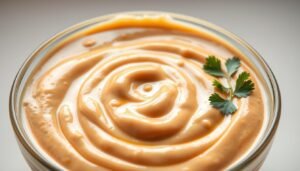Did you know a great side dish can make a meal better? I’m excited to share my Easy Dirty Rice Recipe. It’s a tasty and flexible side dish for your favorite meals. Just like a flaky croissant brightens up breakfast, dirty rice can be the highlight of dinner.
Making dirty rice is simple, perfect for when you’re short on time. You can make it in a crock pot, as I showed in my Easy Crock Pot Dirty Rice guide. It’s not only easy but also full of flavor, making it a great side dish for any meal.
Key Takeaways
- Easy to make in a crock pot
- Versatile side dish for various main courses
- Packed with flavor and hearty ingredients
- Perfect for busy days when you need a quick and satisfying side dish
- Can be customized with your favorite ingredients
What is Dirty Rice?
Dirty rice is a key part of Cajun cuisine. It’s called ‘dirty’ because of its mix of ingredients with rice. This dish is not just tasty but also has a deep history and cultural value.
Origins of Dirty Rice
Dirty rice comes from Cajun and Creole cooking. It’s loved for its bold taste and hearty mix. It was made to use every part of the animal, making it a filling meal. For more on its history, check out this detailed recipe that dives into its cultural importance.
“Dirty rice is more than just a side dish; it’s a reflection of the resourcefulness and culinary creativity of the Cajun people.”
Key Ingredients
The secret to a great dirty rice recipe is in its ingredients. It usually has:
- Rice
- Ground meat (often pork or a mix of meats)
- Vegetables like onions, bell peppers, and celery
- Spices, including cayenne pepper and paprika
Together, these ingredients make a dish that’s both tasty and fragrant.
| Ingredient | Role in Recipe |
|---|---|
| Rice | Base of the dish |
| Ground Meat | Adds protein and flavor |
| Vegetables | Contributes to texture and flavor |
| Spices | Enhances the overall taste |
Variations of Dirty Rice
Dirty rice has evolved over time, with different regions and cooks adding their own twist. This makes it a favorite among many.
Some recipes might include chicken or sausage for extra flavor. Others might use local ingredients for a more sustainable dish.
Essential Ingredients for a Great Dirty Rice Recipe
Choosing the right ingredients is key to making great dirty rice. This dish is a favorite in Southern cuisine. Its taste comes from the ingredients used.
Rice Types: Long Grain vs. Short Grain
The rice type greatly affects dirty rice’s texture and taste. Long grain rice stays firm and separate. On the other hand, short grain rice gets sticky and clings together.
| Rice Type | Texture After Cooking | Suitability for Dirty Rice |
|---|---|---|
| Long Grain Rice | Firm and Separate | High |
| Short Grain Rice | Sticky and Clingy | Low |
Flavorful Additions: Vegetables and Spices
Vegetables and spices are essential for dirty rice’s flavor. Onions, bell peppers, and celery add depth. Spices like paprika and thyme make the dish aromatic.
“The secret to a great dirty rice is in the balance of flavors. You want a mix that’s savory, slightly spicy, and aromatic.”
I sauté the vegetables until they’re tender. This brings out their sweetness, balancing the savory and spicy flavors.
Choosing the Right Meat
The meat choice can greatly enhance dirty rice’s flavor. Andouille sausage is a favorite for its smoky, spicy taste. But chicken liver or ground pork can also add richness and depth.
- Andouille sausage for a spicy kick
- Chicken liver for added richness
- Ground pork for a traditional flavor
Step-by-Step Instructions for Making Dirty Rice
Follow these steps to make a tasty dirty rice dish. It’s a family favorite. You’ll prepare the rice, cook the meats and veggies, and mix everything together.
Preparing the Rice
Start by preparing the rice. Use long-grain rice for the best results. Rinse it until the water is clear. Then, let it drain.
For more rice cooking tips, check out this dirty rice recipe from The New York Times.
Cooking the Meats and Vegetables
While the rice drains, cook the meats and veggies. Dirty rice often includes sausage, chicken, or bacon. Cook the meat in a skillet until it’s browned and crumbled.
Add diced onions, bell peppers, and celery next. These are key in Cajun cooking. Cook until the veggies are soft.
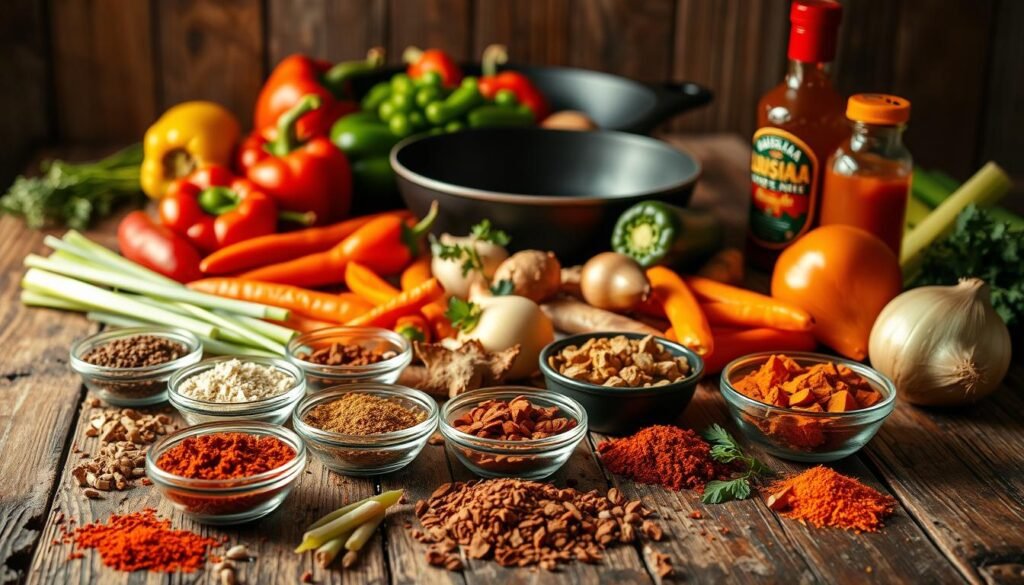
Combining Ingredients and Seasoning
Now, mix the cooked rice with the meat and veggie mixture. Add spices like paprika, thyme, and cayenne pepper. Mix well to coat the rice evenly.
Taste and adjust the seasoning as needed.
| Ingredient | Quantity | Purpose |
|---|---|---|
| Rice | 1 cup | Base of the dish |
| Sausage/Meat | 1 cup, cooked | Adds protein and flavor |
| Onions, Bell Peppers, Celery | 1 cup, diced | Adds flavor and texture |
| Spices (Paprika, Thyme, Cayenne) | To taste | Enhances flavor |
By following these steps, you’ll make a delicious dirty rice dish. It’s great as a side or main course. Enjoy making it and feel free to customize it to your taste.
Tips for Perfecting Your Dirty Rice
Dirty rice is a key dish in Southern cuisine. To make it great, you need to know how to cook, season, and avoid common mistakes.
Cooking Techniques for Fluffy Rice
Getting fluffy rice is key to making great dirty rice. Use long grain rice, as it keeps its shape well and doesn’t get mushy.
Rinse the rice well to remove starch. This helps it not stick together. Use a 2:1 liquid to rice ratio. Boil the liquid, add rice, cover, and simmer until it’s absorbed.
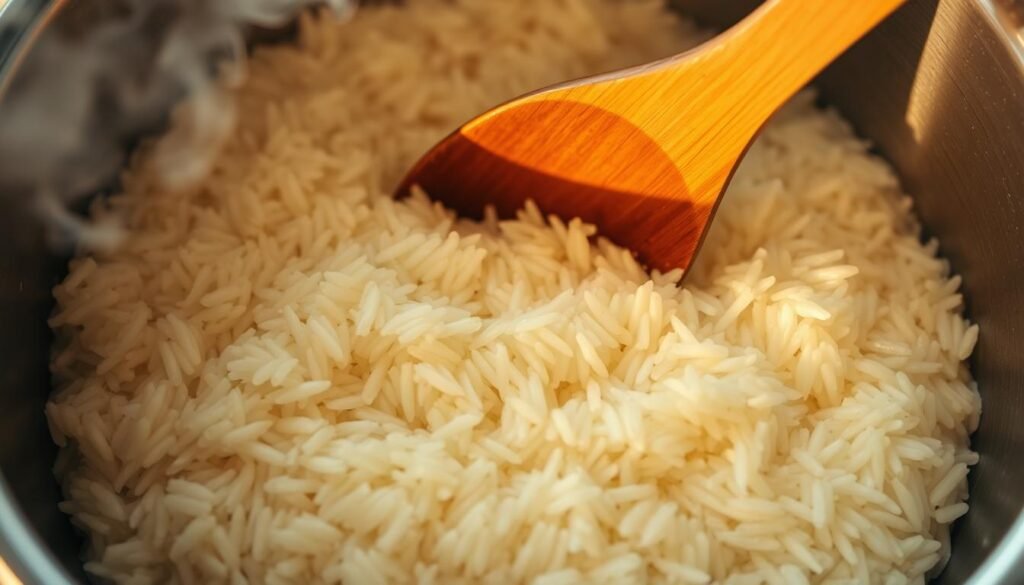
Balancing Flavors with Seasonings
Seasoning is vital for tasty dirty rice. You want all flavors to balance well. Start with sautéed onions, bell peppers, and celery.
Add your meat or protein and cook until it’s fully mixed. Season with salt, pepper, and spices. Taste and adjust as you go.
Common Mistakes to Avoid
Even with great ingredients, dirty rice can fail if you make common cooking mistakes. Overcooking makes rice mushy. Not enough seasoning makes it bland.
- Not rinsing the rice before cooking, which can cause it to become sticky.
- Using the wrong type of rice, such as short grain rice, which can become too soft.
- Not adjusting the seasoning throughout the cooking process.
Avoid these mistakes and follow these tips to make delicious, authentic dirty rice. It will impress everyone.
Serving Ideas for Dirty Rice
Dirty rice is more than a side dish; it’s a canvas for creativity. You can pair it with main dishes, make a complete meal, or use leftovers. It offers endless possibilities.
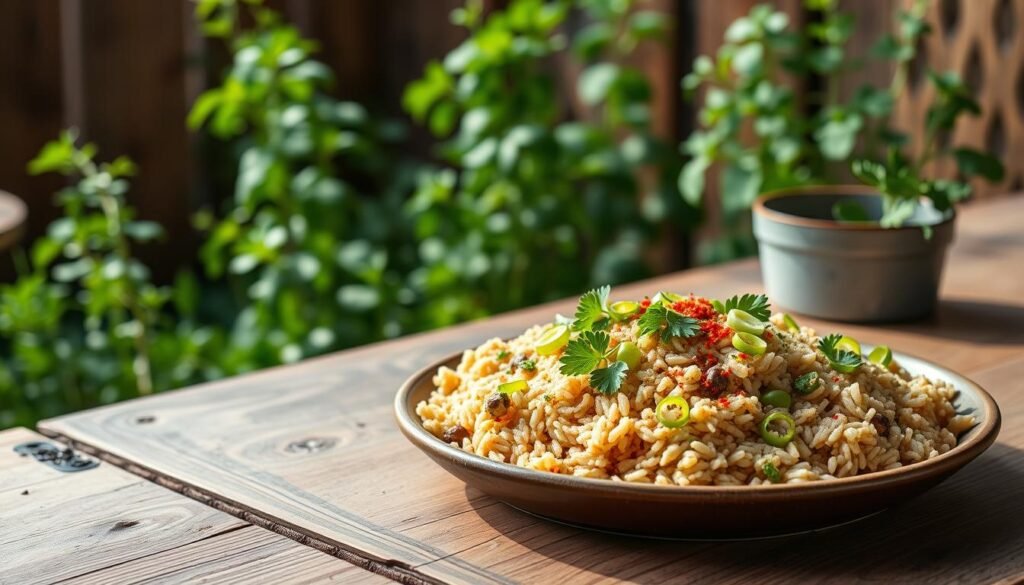
Pairing with Main Dishes
Pairing dirty rice with your favorite main dishes is simple. It goes well with chicken and steak, adding flavor. For a Southern twist, try it with fried chicken or grilled catfish.
It also works with roasted veggies or a fresh salad for a lighter meal. The trick is to balance flavors so the rice enhances the dish without overpowering it.
Transforming It into a Complete Meal
To make dirty rice a complete meal, add protein like sausage, shrimp, or chicken. Mix in veggies like bell peppers, onions, or mushrooms for more nutrition and taste.
For a vegetarian or vegan option, use tofu or tempeh instead of meat. Add spices to keep the flavor rich.
Creative Leftover Ideas
Leftover dirty rice can be used in many ways. Try it as a filling for stuffed peppers or cabbage rolls. Mix it with protein and spices, fill the peppers or cabbage, and bake until tender.
Another idea is to shape it into patties, coat with breadcrumbs, and pan-fry until crispy. This makes a tasty snack or side dish.
Healthy Variations of Dirty Rice
Healthy versions of dirty rice are tasty and easy to make. Just a few tweaks can make this classic dish nutritious.
Changing the ingredients is a big step towards a healthier dirty rice. Let’s look at some ways to do this.
Substituting Meats
Dirty rice often has sausage or bacon, which are high in fat and salt. To make it better, try using leaner meats instead.
- Choose chicken or turkey sausage over pork sausage.
- Go for lean ground turkey or chicken instead of beef or pork.
- For a plant-based option, use tofu or tempeh.
Adding More Vegetables
Adding more veggies can make dirty rice even healthier.
Try adding bell peppers, carrots, and mushrooms. They boost the fiber, vitamins, and minerals.
| Vegetable | Nutritional Benefit |
|---|---|
| Bell Peppers | High in Vitamin C and antioxidants |
| Carrots | Rich in Vitamin A and fiber |
| Mushrooms | Good source of Vitamin D and antioxidants |
Using Brown Rice or Quinoa
Switching to brown rice or quinoa can make dirty rice much healthier.
Brown rice has more fiber and nutrients than white rice. Quinoa is a complete protein and packed with iron and magnesium.
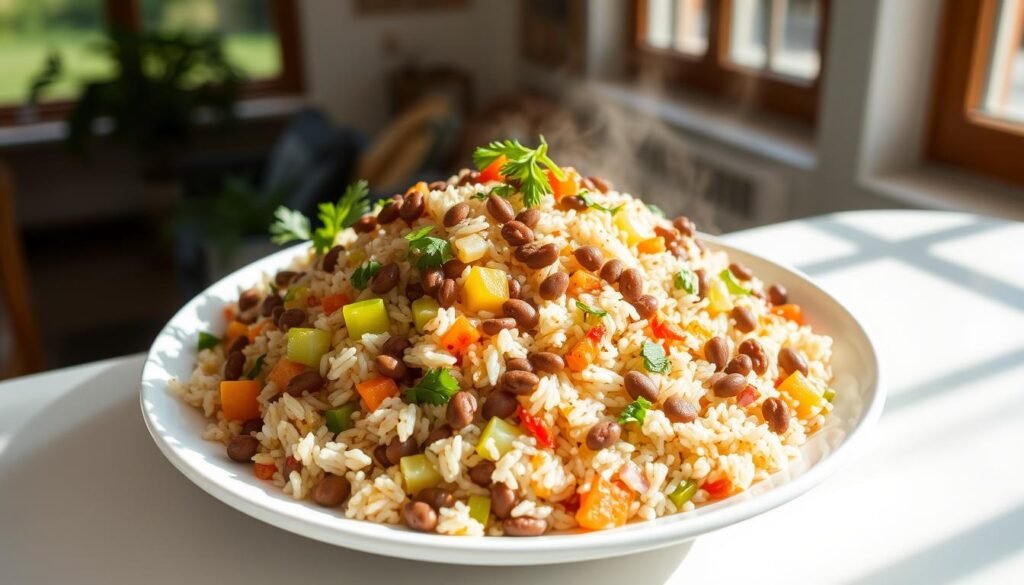
Storing and Reheating Dirty Rice
To enjoy your dirty rice for days, it’s key to store and reheat it right. Storing it properly keeps its taste and texture fresh.
Best Practices for Storage
For storing dirty rice, an airtight container is a must. It keeps moisture and other tastes out. Let the rice cool down to room temperature before refrigerating to avoid sogginess.
Cooling Tips: Spread the rice on a big plate or tray to cool it fast. This step stops bacteria from growing.
After cooling, put the rice in an airtight container. Store it in the fridge for 3-4 days. If you won’t eat it in that time, freeze it.
- Use airtight containers to store dirty rice.
- Cool the rice to room temperature before storing.
- Refrigerate for up to 3-4 days or freeze for longer storage.
How to Reheat Without Losing Flavor
Reheating dirty rice needs some care to keep its taste and texture. The microwave is fast, but it can heat unevenly.
Microwave Reheating: Put the rice in a microwave-safe dish. Add a tablespoon of water or broth. Cover it with a lid or plastic wrap. Heat in 30-second bursts, stirring between, until hot.
For better control, use the stovetop. Add a little broth or water. Cover and heat on low, stirring often, until warm.
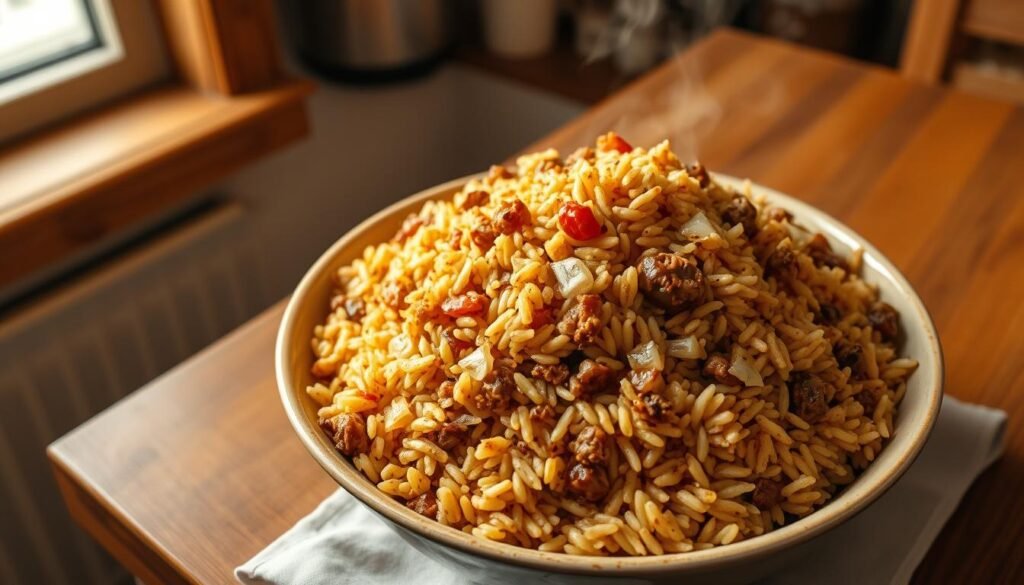
Stovetop Reheating Tips: Stir the rice often to stop it from sticking. If it’s too dry, add more broth or water.
Popular Culture References to Dirty Rice
Dirty rice is more than just a dish; it’s a key part of Southern cooking. It’s loved in many homes and restaurants for its rich taste and history.
Dirty Rice in Southern Cuisine
Dirty rice is a big part of Southern food, often paired with gumbo and jambalaya. It’s a favorite at family meals and community events. People love it for its warm, comforting taste.
“Dirty rice is the unsung hero of Southern cuisine. It’s a dish that warms the heart and fills the belly, a true comfort food.” –
In Southern homes, dirty rice is a common side dish. It goes well with many main dishes. Its rich flavor and versatility make it a hit with everyone.
Celebrating Dirty Rice in Restaurants
Restaurants all over the South feature dirty rice on their menus. Chefs add their own twist, using local ingredients and new cooking methods. This makes the dish even more special.
| Restaurant | Location | Dirty Rice Variation |
|---|---|---|
| The Southern Table | New Orleans, LA | Spicy Dirty Rice with Andouille Sausage |
| Cajun Kitchen | Baton Rouge, LA | Classic Dirty Rice with a Side of Gumbo |
| Bayou Bites | Charleston, SC | Lowcountry Dirty Rice with Shrimp and Bacon |
Restaurants celebrate dirty rice for its role in Southern cuisine and its flexibility. It’s enjoyed in many ways, from traditional to modern. Dirty rice remains a favorite in the South.
Final Thoughts on Making Dirty Rice
Thinking about this dirty rice recipe reminds me why it’s loved by many. Its simplicity and flavor make it a staple. Plus, it’s easy to make it your own.
Simplifying Your Meal Prep
Adding your favorite ingredients and tweaking the seasonings can turn this side dish into a full meal. It’s perfect for any occasion, from weeknight dinners to special events. This recipe is sure to become a favorite.
Making it Your Own
Don’t be afraid to try new meats, veggies, and spices to make your own dirty rice. This recipe is just the beginning. You can add your own twist to this classic dish.

